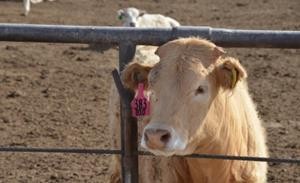Chuck Dodd, a veterinarian in the U.S. Army, currently disguised as a graduate student in Food Science at Kansas State University who spends a lot of time collecting poop (right below, exactly as shown), writes that researchers have now concluded that some cows present a greater risk for beef contamination by shedding higher concentrations of Escherichia coli O157 in their feces.
Some food safety researchers, including me, have begun to label these cows as super-shedders. But that may be a witch hunt, or in this case, a super-shedder hunt.
Escherichia coli O157 remains a significant cause of foodborne illness in the United States. From 1982 to 2002, there were 350 reported outbreaks of E. coli O157 in which 8,598 people became ill. Almost 1,500 were hospitalized and 40 died. During this period, 41 percent of food-related E. coli O157 outbreaks were associated with the consumption of contaminated ground beef. Ground beef that came from cattle. Cattle that may have been shedding very high levels of E. coli O157 in their feces.
Cattle do not get sick if they carry E. coli O157 in their feces. A cow with E. coli O157 looks just like any other cow. In order to discriminate, the feces must be tested. Test methods have improved and now the organisms can be detected at lower concentrations in the feces. The numbers of organisms can also be estimated; hence, food safety researchers are able to separate the super-shedders from the low-shedders. Cattle can also be identified that are not carrying E. coli O157.
 Studies have shown that E. coli O157 in cattle feces or on cattle hides is correlated with the detectable presence of E. coli O157 on the carcass. Carcass contamination likely occurs during the hide removal and evisceration process; this leads to the contamination of individual beef products sold at retail. In order to mitigate the risk of E. coli O157 contamination in ground beef, the beef industry employs pre- and post-harvest interventions. Yet some bacteria still make it through the harvest process.
Studies have shown that E. coli O157 in cattle feces or on cattle hides is correlated with the detectable presence of E. coli O157 on the carcass. Carcass contamination likely occurs during the hide removal and evisceration process; this leads to the contamination of individual beef products sold at retail. In order to mitigate the risk of E. coli O157 contamination in ground beef, the beef industry employs pre- and post-harvest interventions. Yet some bacteria still make it through the harvest process.
Researchers are now scrutinizing cattle because their feces may have a super-sized dose of E. coli O157. Their theory: if the beef industry can detect and mitigate super-shedders, they can mitigate contamination of beef.
But is super-shedding super-bad? Maybe not.
Cattle with higher concentrations of E. coli O157 in their feces probably pose a higher risk for the eventual contamination of beef; however, the fecal shedding of these organisms comes and goes. Fecal shedding may depend upon host immunity and the environment (neither of which are the cow’s fault). What if a super-shedder on Saturday becomes a low-shedder on Sunday? What if a super-shedder is simply having a bad E. coli day? Does a high fecal concentration of E. coli O157 overwhelm the interventions that exist from farm-to-fork?
Researchers have asked whether the variation in fecal shedding “arises from the inherent stochasticity in transmission dynamics or is a signature of underlying heterogeneities in the cattle population.” Translation: are the differences in fecal shedding simply random or is it because cattle are simply different? Apparently, the fecal shedding of E. coli O157 varies by animal and by day.
Admittedly, due to the transience of E. coli O157 in cattle, a steer may shed a lot on the day of harvest. Nevertheless, if transience is real, then some days cattle may pose a high risk, low risk, or negligible risk.
The new super-shedder hunt may lengthen the path in preventing foodborne illness due to E. coli O157. Some cattle carry E. coli O157 and some don’t. There may be some benefit in knowing which cattle are shedding more than 100,000 E. coli O157 per gram in their feces on a given day, but will this knowledge prevent beef contamination? Perhaps, if it is the day of harvest.
 Large variations of E. coli O157 shedding in cattle exist and vary in the number of cattle positive for E. coli O157 and the amount of bacteria (c.f.u./g feces) shed by positive animals. To investigate E. coli O157 shedding and super-shedding (>104 c.f.u./g) we used daily sampling over two 8-day periods; in January 2013 (n = 12) and February 2013 (n = 21).
Large variations of E. coli O157 shedding in cattle exist and vary in the number of cattle positive for E. coli O157 and the amount of bacteria (c.f.u./g feces) shed by positive animals. To investigate E. coli O157 shedding and super-shedding (>104 c.f.u./g) we used daily sampling over two 8-day periods; in January 2013 (n = 12) and February 2013 (n = 21).
